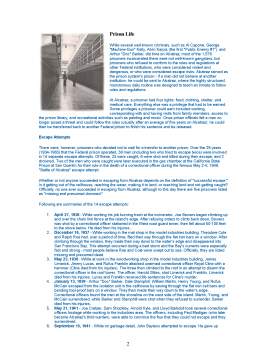Extras din referat
Before the Prison
The name Alcatraz is derived from the Spanish "Alcatraces." In 1775, the Spanish explorer Juan Manuel de Ayala was the first to sail into what is now known as San Francisco Bay - his expedition mapped the bay and named one of the three islands Alcatraces. Over time, the name was Anglicized to Alcatraz. While the exact meaning is still debated, Alcatraz is usually defined as meaning "pelican" or "strange bird."
In 1850, a presidential order set aside the island for possible use as a United States military reservation. The California Gold Rush, the resulting boom in the growth of San Francisco, and the need to protect San Francisco Bay led the U.S. Army to build a Citadel, or fortress, at the top of the island in the early 1850s. The Army also made plans to install more than 100 cannons on the island, making Alcatraz the most heavily fortified military site on the West Coast. Together with Fort Point and Lime Point, Alcatraz formed a "triangle of defense" designed to protect the entrance to the bay. The island was also the site of the first operational lighthouse on the West Coast of the United States.
By the late 1850s, the first military prisoners were being housed on the island. While the defensive necessity of Alcatraz diminished over time (the island never fired its guns in battle), its role as a prison would continue for more than 100 years. In 1909, the Army tore down the Citadel, leaving its basement level to serve as the foundation for a new military prison. From 1909 through 1911, the military prisoners on Alcatraz built the new prison, which was designated the Pacific Branch, U.S. Disciplinary Barracks for the U.S. Army. It was this prison building that later became famous as "The Rock."
The Rock
The U.S. Army used the island for more than 80 years--from 1850 until 1933, when the island was transferred to the U.S. Department of Justice for use by the Federal Bureau of Prisons. The Federal Government had decided to open a maximum-security, minimum-privilege penitentiary to deal with the most incorrigible inmates in Federal prisons, and to show the law-abiding public that the Federal Government was serious about stopping the rampant crime of the 1920s and 1930s.
USP Alcatraz was not the "America's Devil's Island" that many books and movies portray. The average population was only about 260-275 (the prison never once reached its capacity of 336 - at any given time, Alcatraz held less than 1 percent of the total Federal prison population). Many prisoners actually considered the living conditions (for instance, always one man to a cell) at Alcatraz to be better than other Federal prisons, and several inmates actually requested a transfer to Alcatraz.
Birdman
The island's most famous prisoner was probably Robert Stroud, the so-called "Birdman of Alcatraz." In reality, Stroud never had any birds at Alcatraz, nor was he the grandfatherly person portrayed by Burt Lancaster in the well-known movie. In 1909, Stroud was convicted of manslaughter; while serving his prison sentence at the U.S. Penitentiary (USP), McNeil Island, Washington, he viciously attacked another inmate. This resulted in his transfer to USP Leavenworth, Kansas. In 1916, he murdered a Leavenworth guard, was convicted of first-degree murder, and received a death sentence. His mother pleaded for his life, and in 1920, President Woodrow Wilson commuted the death sentence to life imprisonment.
It was Stroud's violent behavior that earned him time in segregation. During his 30 years at Leavenworth, he developed his interest in birds and eventually wrote two books about canaries and their diseases. Initially, prison officials allowed Stroud's bird studies because it was seen as a constructive use of his time. However, contraband items were often found hidden in the bird cages, and prison officials discovered that equipment Stroud had requested for his "scientific" studies had actually been used to construct a still for "home-brew." Stroud was transferred to Alcatraz in 1942, where he spent the next 17 years (6 years in segregation in "D Block" and 11 years in the prison hospital). In 1959, he was transferred to the Medical Center for Federal prisoners in Springfield, Missouri, where he died on November 21, 1963.
Prison Life
While several well-known criminals, such as Al Capone, George "Machine-Gun" Kelly, Alvin Karpis (the first "Public Enemy #1"), and Arthur "Doc" Barker, did time on Alcatraz, most of the 1,576 prisoners incarcerated there were not well-known gangsters, but prisoners who refused to conform to the rules and regulations at other Federal institutions, who were considered violent and dangerous, or who were considered escape risks. Alcatraz served as the prison system's prison - if a man did not behave at another institution, he could be sent to Alcatraz, where the highly structured, monotonous daily routine was designed to teach an inmate to follow rules and regulations.
Preview document
Conținut arhivă zip
- About Alcatraz.doc




